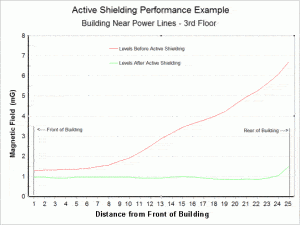Our active magnetic shielding systems are used primarily for reducing powerline magnetic fields. They are effective for both transmission and distribution lines, overhead or underground. Within a defined area, the magnetic field can often be reduced to a very low level. While passive shielding using metal plates is commonly used for single rooms, active shielding is usually the only practical approach to power line field mitigation at the whole-building level. Similar technology is commonly used for room-level field reduction for scanning electron microscopes (SEMs) and other electron beam devices, but our work is limited to wide area, building level applications. We currently have systems installed and operating throughout the U.S., Canada, Israel, and Sweden, in commercial, school, and residential environments.

Significant misconceptions exist about the true nature of active magnetic shielding (active cancellation) and its use as a field reduction modality. This is partly because magnetic field remediation techniques are poorly understood by many people, and partly because, until recent years, active shielding has seen limited use outside the laboratory environment. The problem is exacerbated by the availability of outrageous products on the consumer market which claim to cancel EMF through various unexplained means, but which in reality do nothing at all.
A magnetic field can be thought of as a force that has both strength and direction. If it is met with an equal force of exactly opposite direction, the forces will cancel and the net force will be zero, within a defined area. This is the basic principle of active cancellation. Fundamental principles of physics are applied in the real world to solve a problem. The term “cancellation” is sometimes taken to mean complete elimination, but this is never achieved. Rather, EMF cancellation efficiencies of 65% to 90% are typical. From this perspective, the term “active magnetic shielding” is perhaps more appropriate, although both terms can be used interchangeably.
Performance Examples



During the project





